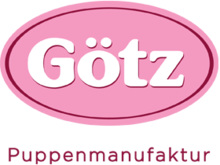

This article has multiple issues. Please help improve it or discuss these issues on the talk page. (Learn how and when to remove these template messages)
|
 | |
| Company type | Gesellschaft mit beschränkter Haftung |
|---|---|
| Götz | |
| Industry | Toys |
| Founded | 1950 (1950) in Rödental, Germany |
| Founder | Marianne and Franz Götz |
| Headquarters | Rödental, Germany |
Area served | Worldwide |
| Products | Dolls and related toys |
| Website | www |
Götz Puppenmanufaktur International[a] (often referred to as Götz Puppenfabrik or Goetz) is a German toy manufacturer, founded in Rödental, Germany, in 1950. This company was recognized internationally for their doll lines. Marianne and Franz Götz were the founders of Götz Puppenfabrik.[1] The company is known to have inspired the classic face mold of the American Girl doll line, back when the doll line was owned by Pleasant Rowland.[2]
1950: Götz Puppenfabrik was founded in 1950, by Marianne and Franz Götz. Franz Götz personally sold and delivered the dolls to their first customers. Götz built the dolls out of papier-mâché initially.[1]
1957: The doll parts were produced using the first model of the rotation-molding machine.[1]
1964: The first reproductions of Sasha Morgenthaler's original artist dolls were manufactured.[1]
1986: Pleasant Rowland, the creator of American Girl, used the model of a Götz branded doll when she presented her idea to create Pleasant Company.[2]
1987: An American secondary branch location of the company was created in Baldwinsville, New York.[1]
1989: Carin Lossnitzer's and Sylvia Natterer's artist dolls were reproduced, leading to an increased consumer base.[1]
1990: A Hungarian and Budapest production center and secondary location were built.[1]
1992: The doll company was given the "Spiel Gut" award.[1]
1994: A Hungarian retail franchise was founded.[1]
1997: Götz Puppenfabrik partnered with Pampolina, another doll company. A doll-and-child clothing line was released, in which children can wear the same outfits as their dolls.[1]
1999: The second generation, Götz Family Anke Götz-Beyer and Uwe Beyer, claimed the corporation management.[1] In Radisson, an American franchise and manufacturing plant of Goetz Dolls Inc. (another name for the company) was opened.[3]
2000: Götz Puppenfabrik received the licensing of "Unser Sandmännchen."[1]
2003: Due to the declining popularity, the final shipment of Götz Puppenfabrik dolls were ordered in Radisson.[4]
2005: A partnership was formed with the Margarethe Steiff GmbH company. The company was given the license, "Hase Felix," in conjunction with the release of a doll from the film, "Felix - Ein Hase auf Weltreise."[1]
2007: "Just Like Me" dolls were introduced as a concept.[1]
2011: "Haarwerk," a toy collection of cosmetics with styling heads, an enlarged version of the doll head that cuts off at the shoulders, was released.[1]
|
| |||||||||||||||||||||||
|---|---|---|---|---|---|---|---|---|---|---|---|---|---|---|---|---|---|---|---|---|---|---|---|
| Models and manufacturers |
| ||||||||||||||||||||||
| Types of manufacture |
| ||||||||||||||||||||||
| Collections in museums |
| ||||||||||||||||||||||
| Related topics |
| ||||||||||||||||||||||
| |||||||||||||||||||||||